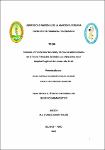| dc.contributor.advisor | Ocampo Falcón, Charles | |
| dc.contributor.author | Raygada Ramírez, Patricia Milagros | |
| dc.contributor.author | Rengifo Ojaicuro, Lorely | |
| dc.date.accessioned | 2018-06-13T17:36:32Z | |
| dc.date.available | 2018-06-13T17:36:32Z | |
| dc.date.issued | 2018 | |
| dc.identifier.uri | http://repositorio.unapiquitos.edu.pe/handle/20.500.12737/5406 | |
| dc.description.abstract | Introducción: La Ictericia Neonatal se define como la coloración amarillenta de piel
y mucosas, originada por concentraciones de bilirrubina sérica anormalmente altas.
En la mayoría de las veces es ocasionada a expensas de bilirrubina indirecta.
Objetivo: Determinar la relación entre ictericia neonatal y fármacos administrados
en el tercer trimestre de embarazo a gestantes en el Hospital Regional de Loreto
durante el año 2016.
Materiales y métodos: El tipo de estudio fue cuantitativo, transversal, retrospectivo
y no experimental, no se manipularon las variables del estudio y los datos que se
utilizaron para la investigación ocurrieron en un periodo de 12 meses. El tamaño de
la muestra fue de 248 casos, los cuales fueron seleccionados en forma sistemática.
Resultados: La prevalencia de ictericia neonatal fue del 2,34%; la incidencia de
ictericia fisiológica fue 69,8% y de ictericia patológica fue 30,2%; la prevalencia de
ictericia neonatal según el sexo corresponde al sexo masculino con el 72,2% y el
sexo femenino con el 27,8%. La mayor frecuencia de fármacos administrados
durante el tercer trimestre de embarazo fue la oxitocina con el 50,8%; seguido de la
ceftriaxona con el 41,5%; la mayor frecuencia de las patologías asociadas por las
cuales las madres de los neonatos recibieron algún fármaco corresponden a
infección del tracto urinario con el 57,7%, e inducción del trabajo de parto con el
47,2%; la mayor frecuencia de duración de fármacos administrados a las madres fue
de 5 a 6 días con el 35,9%.
Conclusiones: Existe una asociación entre ictericia neonatal y fármacos
administrados a las madres gestantes en el tercer trimestre de embarazo, donde
existe 19 veces más el riesgo de presentar ictericia neonatal en aquellas madres a
quienes se les administró metoclopramida, 18 veces más el riesgo cuando se
administró diclofenaco, 16 veces más el riesgo cuando se administró ceftriaxona. | es_PE |
| dc.description.abstract | Introduction: Neonatal jaundice is defined as the yellowing of the skin and mucous,
caused by abnormally high serum bilirubin concentrations. In most cases it is caused
at the expense of indirect bilirubin.
Objective: Determine the relationship between neonatal jaundice and drugs
administered in the third trimester of pregnancy to pregnant women at the
Regional Hospital of Loreto during the year 2016.
Materials and methods: The type of study was quantitative, cross-sectional,
retrospective and non-experimental, the study variables were not manipulated and
the data used for the investigation occurred in a period of 12 months. The sample
size was 248 cases, which were selected systematically.
Results: The prevalence of neonatal jaundice was 2.34%; the incidence of
physiological jaundice was 69.76% and pathological jaundice was 30.24%; the
prevalence of neonatal jaundice according to sex corresponds to the male sex with
72.2% and the female sex with 27.8%. The highest frequency of drugs administered
during the third trimester of pregnancy was oxytocin with 50.8%; followed by
ceftriaxone with 41.5%; the higher frequency of associated pathologies for which
the mothers of the neonates received some drug correspond to urinary tract
infection with 57.7%, and induction of labor with 47.2%; the frequency of duration
of drugs administered to the mothers were of 5 to 6 days with 35.9%.
Conclusions: There is an association between neonatal jaundice and drugs
administered to pregnant women in the third trimester of pregnancy, where there
is 19 times more risk of presenting neonatal jaundice in those mothers who were
administered metoclopramide, 18 times more risk when was administered
diclofenac, 16 times more risk when was administered ceftriaxone. | en_US |
| dc.description.uri | Tesis | es_PE |
| dc.format | application/pdf | es_PE |
| dc.language.iso | spa | es_PE |
| dc.publisher | Universidad de la Amazonía Peruana | es_PE |
| dc.rights | info:eu-repo/semantics/openAccess | es_PE |
| dc.rights | Attribution-NonCommercial-NoDerivs 3.0 United States | * |
| dc.rights.uri | http://creativecommons.org/licenses/by-nc-nd/3.0/us/ | * |
| dc.source | Universidad Nacional de la Amazonía Peruana | es_PE |
| dc.source | Repositorio institucional - UNAP | es_PE |
| dc.subject | Ictericia neonatal | es_PE |
| dc.subject | Fármacos | es_PE |
| dc.subject | Tercer trimestre del embarazo | es_PE |
| dc.title | Relación entre ictericia neonatal y fármacos administrados en el tercer trimestre de embarazo a gestantes en el hospital regional de Loreto, año 2016 | es_PE |
| dc.type | info:eu-repo/semantics/bachelorThesis | es_PE |
| thesis.degree.discipline | Farmacia y Bioquímica | es_PE |
| thesis.degree.grantor | Universidad Nacional de la Amazonía Peruana. Facultad de Farmacia y Bioquímica | es_PE |
| thesis.degree.level | Título Profesional | es_PE |
| thesis.degree.name | Químico Farmacéutico | es_PE |
| thesis.degree.program | Regular | es_PE |
| dc.subject.ocde | http://purl.org/pe-repo/ocde/ford#3.01.05 | es_PE |


